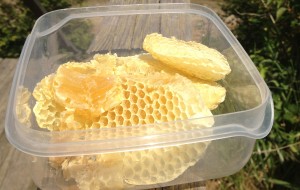 A few days ago, I wrote about crazy comb, my name for burr or wild comb. I’d found it on my fourth hive inspection in the new medium super I had put on top of their brood box. While trilled that they were building new comb, I was confused as to how to understand this strange comb design.
A few days ago, I wrote about crazy comb, my name for burr or wild comb. I’d found it on my fourth hive inspection in the new medium super I had put on top of their brood box. While trilled that they were building new comb, I was confused as to how to understand this strange comb design.
The answers came from the Boston Beekeepers Club, from a very helpful beek named Megan, and bee expert named Jean-Claude who taught a class I took, and who also sold me the nuc to start my hive.
If you think about it, traditionally bees make their hives in hollow trees and other formations that provide a cavity. They start to build comb, and build it down, further and further, as long as it’s stable. Sometimes it touches the bottom of the cavity, but often stays suspended like a stalactite. When I put the new super on top of their existing brood box, I expected them to fly to the top of the new super and start building new comb down to eventually meet up with the original brood box. But why would they do that? They don’t do this in nature. As I have heard time and time again from experienced beeks:
Make changes in line with nature – not against it.
As Jean-Claude suggested, beeks often add on supers in exactly the opposite way they bees are engineered to build them out. Instead, by putting a new super on the bottom of the existing boxes, we are extending the cavity, and letting them naturally extend their comb by building it down instead of forcing bees up, and then down.
So today I swapped their bottom brood box, about 30 pounds by my estimation, with the new super, thus allowing them to build out the new comb as an extension from the top brood box. And yes, they were pissed about the intrusion. As soon as I started to force a crack in the seam between their brood box and the screen bottom below it, a few hundred swarmed me with that angry buzz. I swear that had tiny pitchforks and torches. I had to stop and pull out a smoker to complete the work, something I only use when absolutely necessary.
As a bonus, I followed Megan’s suggestions to keep the burr comb, now mostly filled with uncapped honey. While I’m sure their traditional honey will taste better, I can tell you that their work-in-progress uncapped honey tastes yummy!

